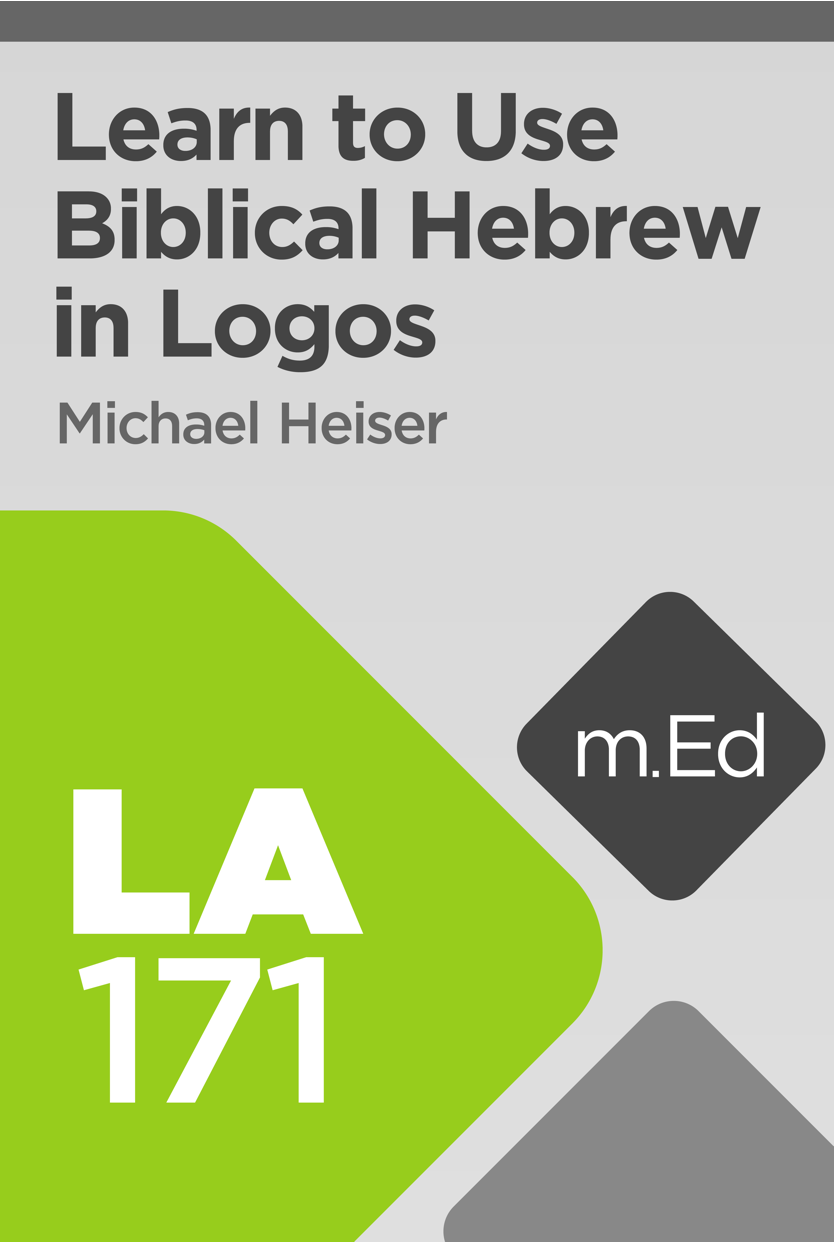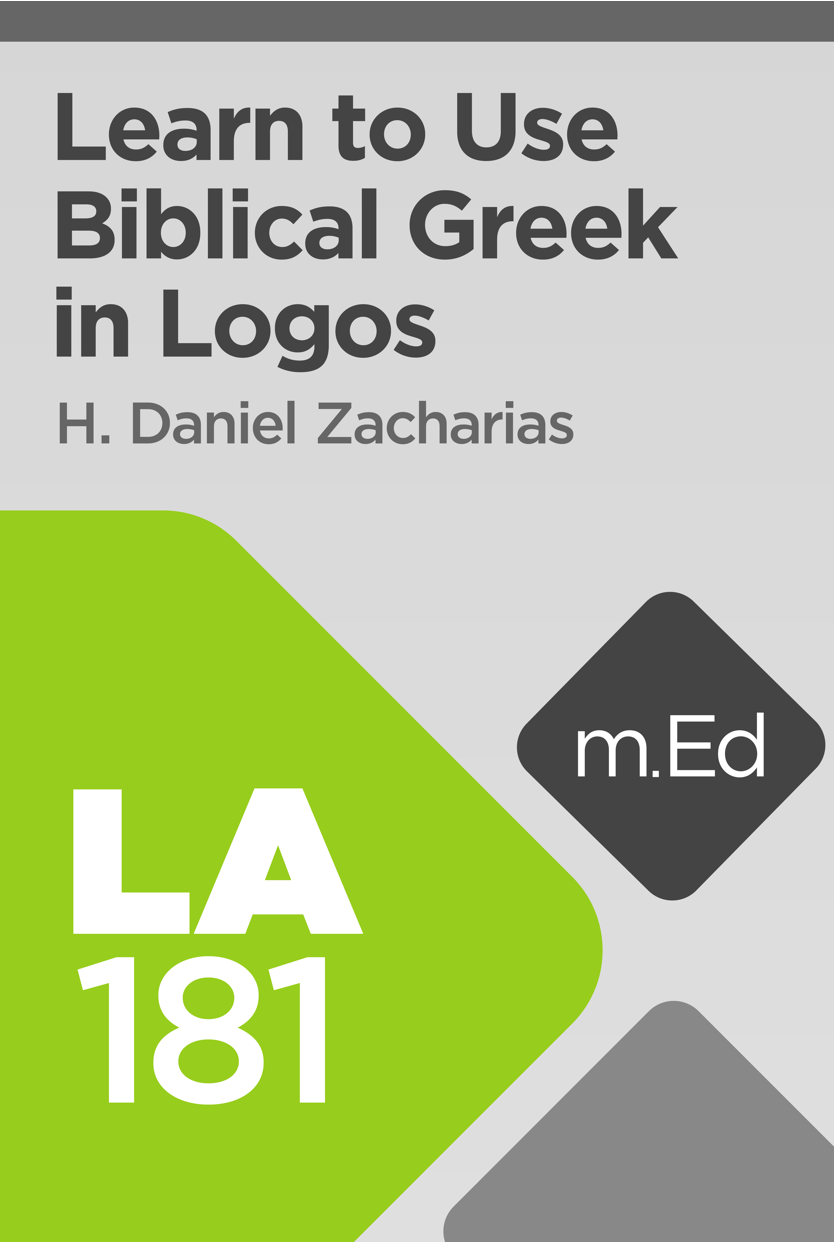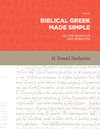Mobile Ed: Learn to Use Biblical Greek and Hebrew in Logos (2 courses)
Digital Logos Edition
Overview
Whether you want to learn Greek and Hebrew for the first time or are simply looking for a refresher, Michael Heiser and H. Daniel Zacharias are excellent guides. With this tools-based approach, you’ll learn the terminology, tools, and methods needed to interpret words and passages of Scripture—without memorization.
- Focused on exegesis. Rather than having you memorize vocabulary or translate phrases into English, lessons focus on using Greek and Hebrew to interpret the meaning of the text. Learn grammatical terms and concepts, proper methods for doing word studies, and common mistakes to avoid.
- Equipping you with tools. Video tutorials show you how to use the advanced language tools in Logos. You’ll also learn how to use dictionaries and lexicons, reverse interlinears, commentaries, and more.
- Connected to your library. Each course is transcribed and becomes a searchable Logos resource connected to grammars, reverse interlinears, and other resources in your library. Read along as you watch the lectures and jump to recommended readings with a click.
- Learning on your schedule. Watch 5–10-minute lectures from your mobile device or computer, whenever your schedule allows. Set your own pace, and then track your progress with quizzes and exams. These courses contain over 20 hours of lectures and demonstrations that will take you all the way from understanding the basics to performing practical advanced research techniques.

- LA171 Learn to Use Biblical Hebrew in Logos by Michael S. Heiser with Joshua R. Westbury
- LA181 Learn to Use Biblical Greek in Logos by H. Daniel Zacharias
- Title: Learn to Use Biblical Greek and Hebrew in Logos
- Instructors: Michael S. Heiser and H. Daniel Zacharias
- Publisher: Lexham Press
- Publication Date: 2020
- Product Type: Logos Mobile Education
- Resource Type: Courseware, including transcripts, audio, and video resources
- Courses: 2
- Video Hours: 22

Using a practical approach, Dr. Michael Heiser shows you how to use biblical Hebrew to become a competent interpreter of the Old Testament. Perform word studies alongside an expert and learn to avoid common mistakes. Learn grammatical terminology used in commentaries and journal articles so you can follow the discussion. Dr. Heiser teaches you the concepts and introduces you to the tools, and then walks you through each step of interpretation.
Course Outcomes
Upon successful completion you should be able to:
Contents:
Introduction
- Introducing the Speaker and Course
Unit 1: Preliminary Matters
- Conceptual Introduction
- Payoff of This Course
- Reverse Interlinear: Primary Tool
- Why the Centerpiece?
- Roadmap for the Course
Unit 2: Tools for Word Studies
- Some Common Tools
- Dictionaries and Lexicons
- Types of Lexicons
- Theological Lexicons
- Lexicons’ Use of Strong’s Numbers
- Lexical Tools That Use Strong’s Numbers
- Limitations of Strong’s Dictionary
Unit 3: English Words and Word Meanings
- How Do Words “Mean”?
- Polysemy
- Contexts
- Relationships to Other Words
- Synonyms
- Antonyms
- Homographs
- How Words Don’t “Mean”
- English Words and Meanings: Summary
Unit 4: Hebrew Words and English Translations
- Polysemy and Translation
- One English Word Translating Different Hebrew Words
- About Hebrew Words
- Root Fallacy
- Sound Fallacy
- Homograph Fallacy
- Core Meaning Fallacy
- “Hebrew Thought” versus “Greek Thought” Fallacy
- Hebrew Words: Summary and Review
Unit 5: Methods for Studying Hebrew Words
- Previewing the Methods
- Inadequate versus Sound Methods
- Gathering Data: Occurrences
- Gathering Data: Glosses
- Thinking about the Data
- Word Distribution
- Semantic Range
- Thinking about Distribution
- Grammar and Syntax
- Meaning of עַלְמָה (ʿalmâ): Tentative Conclusions
- Checking Your Conclusions: Loaded Terms
- Checking Your Conclusions: Metaphorical Sense
- Word Studies: Summary
Unit 6: Nouns
- Previewing Morphology, Syntax, and Meaning
- Nouns: Terms and Concepts
- Nouns: Gender and Number
- Nouns: Definiteness and Relationship
- Construct Relationship: Definition
- Construct State: Classes
- Construct Nouns: Interpretive Examples
- Construct Relationship: Noun and Its Suffix
- Construct Noun and Suffix: Interpretive Examples
- Nouns: Appositional Relationship
- Nouns: Definiteness and the Definite Article
- Definite Article and Uniqueness: “The River” = “Nile”
- Definite Article: Uniqueness or Demonstrative Force
- Definite Article: Species or Class
- Definite Article: Functioning Like a Relative Pronoun
- Definite Article: Substitute for Possessive Pronoun
- Definite Article: Signaling a Vocative
- Definite Article: Interesting Cases of Presence or Absence
- Definite Article: Advice and Discovery
Unit 7: Prepositions
- Previewing Prepositions
- Preposition אֶל (ʾel)
- Preposition אֵת (ʾēt)
- Preposition בְּ (b): Locative Use
- Preposition בְּ (b): Other Uses
- Preposition בֵּין (bên)
- Preposition כְּ (k)
- Preposition לְ (l), Part 1
- Preposition לְ (l), Part 2
- Preposition לִפְנֵי (lip̄nê)
- Preposition מִן (min), Part 1
- Preposition מִן (min), Part 2
- Preposition עַד (ʿaḏ)
- Preposition עַל (ʿal), Part 1
- Preposition עַל (ʿal), Part 2
- Preposition עִם (ʿim), Part 1
- Preposition עִם (ʿim), Part 2
- Prepositions: Summary
- Focus on Prepositions
Unit 8: Conjunctions
- Previewing Conjunctions
- Conjunction אִם (ʾim)
- Conjunction אֲשֶׁר (ʾăšer)
- Conjunction כִּי (kî)
- Conjunctions לוּ and לוּלֵא (lû and lûlēʾ)
- Conjunction לְמַעַן (lĕmaʿan)
- Conjunction פֶּן (pen)
- Conjunctions עַל־כֵּן and לָכֵן (ʿal-kēn and lāḵēn)
- Conjunction וְ (w, waw or vav)
- Conjunctions: Advice and Summary
Unit 9: Verbs: Terminology
- Previewing Terminology
- Verbal Tense, Aspect, Voice, and Mood
- Verbal Types
- Verbal Person, Gender, and Number
- Verbal Conjugations
- Verbal Parsing and Morphology
Unit 10: Verbal Tense, Aspect, and Mood
- Previewing Verbal Forms and Stems
- Verbal Tense, Aspect, and Mood: Summary
- Perfect/Suffixed Conjugation (qātal)
- Imperfect/Prefixed Conjugation (yiqtōl)
- Summary of Perfect (qātal) and Imperfect (yiqtōl) Forms
- Perfect (qātal) and Imperfect (yiqtōl) Forms: Examples
- Interpreting the Use of Perfect and Imperfect Conjugations
- Volitional Conjugations
- Volitional Forms: Discovering Examples
- Interpreting the Use of Volitional Forms
- Participles: Functions
- Participles: Tense, Aspect, and Mood
- Participles: Discovering Examples
- Interpreting the Use of Participles
- Infinitives: Functions
- Infinitive Constructs: Discovering Examples
- Interpreting the Use of Infinitive Absolute Constructions
Unit 11: Verbal Stems
- Introducing Verbal Stems
- Eight Major Verbal Stems
- Identifying Verbal Stems and Conjugations
- Rare Stems and Stems in LHB
- Verbal Stem Terminology
- Qal/G Stem
- Discovering Occurrences of the Qal
- Qal Passive/Gp Stem
- Niphal/N Stem
- Discovering Occurrences of the Niphal
- Interpreting the Use of the Niphal
- Piel/D Stem
- Meaning Nuances of the Piel
- Discovering Occurrences of the Piel
- Interpreting the Use of the Piel
- Pual/Dp Stem
- Meaning Nuances of the Pual
- Discovering Occurrences of the Pual
- Interpreting the Use of the Pual
- Hitpael/HtD Stem
- Meaning Nuances of the Hitpael
- Discovering Occurrences of the Hitpael
- Interpreting the Use of the Hitpael
- Hiphil/H Stem
- Meaning Nuances of the Hiphil
- Discovering Occurrences of the Hiphil
- Interpreting the Use of the Hiphil
- Hophal/Hp Stem
- Meaning Nuances of the Hophal
- Discovering Occurrences of the Hophal
- Interpreting the Use of the Hophal
- Rare Verbal Stems
- Verbal Stems: Summary
Unit 12: Verb Changes with Vav Conjunction
- Previewing Verb Sequences
- Wayyiqtōl: Consecutive-Sequential
- Discovering Occurrences of Wayyiqtōl
- Wĕqātal: Conjunctive and Sequential
- Other Verb Chains
Unit 13: Aramaic and Transliteration
- Interpretive Overlaps with Aramaic
- Aramaic and Word Studies
- Aramaic Overlaps and Parallels to Hebrew Stems
- Hebrew Alphabet and Transliteration: א to ל
- Hebrew Alphabet and Transliteration: מ to ת
Conclusion
- Quick Review
- Appendix: The Lexham Discourse Hebrew Bible and the High Definition Old Testament
- Assumptions behind the Resources
- Introducing Discourse
- Choice and Meaning
- Introducing the Lexham Discourse Hebrew Bible and the High Definition Old Testament
- Grammatical Labels and Propositional Outlines
- Using the Lexham Discourse Hebrew Bible and the High Definition Old Testament
- Grammatical Categories: Forward-Pointing Devices
- Studying Tail-Head Linkage
- Grammatical Categories: Thematic Highlighting Devices
- Studying Overspecification
- Grammatical Categories: Word Order Devices
- Studying Fronting
- Key Discourse Resources in Logos
Michael S. Heiser is a former Scholar-in-Residence for Faithlife Corporation, the makers of Logos Bible Software. He currently serves as Executive Director of the Awakening School of Theology and Ministry at Celebration Church in Jacksonville, Florida. His varied academic background enables him to operate in the realm of critical scholarship and the wider Christian community. His experience in teaching at the undergraduate level and writing for the layperson have both directly contributed to Logos’ goal of adapting scholarly tools for nonspecialists. He is the coeditor of Old Testament Greek Pseudepigrapha with Morphology and Semitic Inscriptions: Analyzed Texts and English Translations and can do translation work in roughly a dozen ancient languages. He earned his PhD in Hebrew Bible and Semitic languages and holds an MA in ancient history and Hebrew studies. In addition, he was named the 2007 Pacific Northwest Regional Scholar by the Society of Biblical Literature.

Learn to Use Biblical Greek makes extensive use of Logos tools and resources to teach beginning Greek grammar. Get an in-depth look at reverse interlinears, and understand important Greek lexicons and theological dictionaries and how to best use these resources in Logos. Learn how to do Greek word studies using the Word Study Workflow feature in Logos. Dr. Zacharias introduces you to Greek grammar—nouns, indicative verbs, non-indicative verbs, participles and infinitives, and other parts of speech like prepositions, adjectives, and pronouns.
Course Outcomes
Upon successful completion you should be able to:
Contents:
Introduction
- Introducing the Speaker and Course
Unit 1: Reverse Interlinears
- What Is a Reverse Interlinear?
- Reverse Interlinear English Bible Translations
- Information Included in an Interlinear
- Finding How Many Times a Greek Word Occurs
- Finding Where a Greek Word Is Used
- Septuagint Resources
Unit 2: Word Study Resources
- Introduction: Lexicons and Theological Dictionaries
- Strong’s Dictionary
- Louw-Nida
- Louw-Nida in Reverse Interlinears
- DBL Greek
- Lexham Analytical Lexicon to the Greek New Testament
- BDAG
- Bible Sense Lexicon
- LSJ
- Septuagint Lexicons
- Moulton and Milligan
- TDNT
- NIDNTTE
- EDNT and TLNT
- Lexham Theological Wordbook
Unit 3: Word Studies
- Introduction to Word Studies
- Word Study Workflow
- A Word on Method
- “Sign” in John (Part 1)
- “Sign” in John (Part 2)
- “Sign” in John (Part 3)
- Synthesizing Observations on “Sign”
- “Sign” in the New Testament
- Research Lexicon Entries
- Senses of the Word
- Lemma Discussion in Commentaries
- Outside the Bible and Summative Observations
- Etymological Fallacy
- Semantic Anachronism
- Illegitimate Totality Transfer
- One-Meaning Fallacy
- Separating Meaning from Culture
Unit 4: Grammar: Nouns
- Introducing Grammar
- Overview of English Grammar, Parts of Speech
- Setting up Visual Filters
- Introducing Greek Nouns
- The Nominative Case
- The Genitive Case
- The Dative Case
- The Accusative Case
- The Vocative Case
- Final Word on Noun Cases
Unit 5: Grammar: Indicative Verbs
- Introducing Indicative Verbs
- Voice of Verbs
- Person and Number of Verbs
- Aorist Tense Verbs
- Present Tense Verbs
- Imperfect Tense Verbs
- Future Tense Verbs
- Perfect and Pluperfect Tense Verbs
Unit 6: Grammar: Other Parts of Speech
- Conjunctions
- Prepositions
- The Definite Article
- Adjectives
- Personal Pronouns
- Adjectival Pronouns
- Pronouns That Ask Questions and Introduce Clauses
Unit 7: Grammar: Non-Indicative Verbs and Verbals
- The Imperative
- The Subjunctive
- Conditional Sentences
- The Participle
- Adverbial Participles
- The Infinitive
- Adverbial Infinitives
Conclusion
- Moving Forward in Greek
- Alphabet Interactive
- Audio Greek New Testament
- Biblical Greek Made Simple
- Discourse Greek New Testament
- Greater Understanding of Scripture
H. Daniel Zacharias (PhD, University of Aberdeen / Highland Theological College) is Assistant Professor of New Testament at Acadia Divinity College. He resides in Wolfville, Nova Scotia with his wife Maria and their four children.

Biblical Greek Made Simple: All the Basics in One Semester
- Author: H. Daniel Zacharias
- Publisher: Lexham Press
- Publication Date: 2018
- Pages: 360
- Format: Logos Digital
Diligent study of God’s Word involves engaging with it in the language it was written.
Learning Greek can be a challenging experience for seminary students but it is a critical piece of their education. Engaging with the Bible in its original language will lead to deeper understanding, new insights, and provide tools to enter into the conversation surrounding God’s Word.
Biblical Greek Made Simple is a one-semester textbook that teaches the basics of biblical Greek. Designed with the modern student and curriculum in mind, this grammar introduces all the essential elements of biblical Greek while also utilizing the tools and features of Logos Bible Software to help retain and enhance knowledge of Greek. Each chapter includes exercises tailored to its contents as well as additional teaching material for further advancement. Daniel Zacharias provides a solid overview of the entire biblical Greek system, while challenging students to understand how this ancient language is relevant to meaning and translation.
Danny Zacharias is a master teacher of elementary Greek. I'm delighted to see in this new book, Biblical Greek Made Simple, a coalescence of Dr. Zacharias's scholarly knowledge, pedagogical skill, and technological competence. As many colleges and seminaries already employ Logos Bible Software in the teaching of Greek, this textbook, which integrates learning to use the Logos software alongside a more traditional teaching approach, will prove invaluable.
—Robert L. Plummer, professor of New Testament interpretation, The Southern Baptist Theological Seminary
Why not try teaching or learning Greek as though Bible software was our friend? This is exactly what Danny Zacharias does in this highly innovative approach to acquiring competency in the language of the New Testament and Septuagint. His visual approach to the formation of Greek words is splendid and discussions of grammar and syntax focus well on those facets that are most important for interpretation. I am deeply impressed both by the detailed lesson plans in every chapter that allow for closely guided self-study and the links to professional-quality instructional videos on every aspect of Greek and the use of Logos that make of this book a virtual course in the language in and of itself. Seminary professors and motivated individual learners alike will want to give this a close look.
—David A. deSilva, Trustees' Distinguished Professor of New Testament and Greek, Ashland Theological Seminary
This is a well-organized, thoughtful, and up-to-date approach to learning foundational elements of New Testament Greek. It is an interactive guide, not a dull-and-distant textbook. It makes strategic use of Logos Bible Software to enhance the learning process. I welcome its addition to the very short list of good first-semester guides to beginning the life-long process of learning to read the New Testament in its original language.
—Robert W. Yarbrough, professor of New Testament, Covenant Theological Seminary
H. Daniel Zacharias (PhD, University of Aberdeen / Highland Theological College) is Assistant Professor of New Testament at Acadia Divinity College. He resides in Wolfville, Nova Scotia with his wife Maria and their four children.
Reviews
6 ratings
Jason Whitaker
7/14/2024
Malcolm Webber
8/6/2023
I've gone through the Greek part of this so far and it is outstanding. Focuses on getting to know the Greek using the Logos system and resources. Fantastic for someone new to Greek and for someone who wants to brush up on it!Randall Barkman
3/31/2023

jeffrey allen Hill
10/20/2021
I see allot of people with the same questions what is the difference between this version and the one I already own. It should be upgraded for free to everyone who already purchased the first version
Matt Hamrick
12/18/2020

Joshua
6/10/2020
These two courses are simply amazing! Both Dr Heiser and Dr Zacharias give extensive coverage on using Logos to interpret Hebrew and Greek respectively. They have their different distinctive styles which give added value to understanding how Logos work with different languages. The included book Biblical Greek Made Simple follows a more traditional way of learning Greek which although is quite different from the video course, give additional value to the bundle. Overall, the courses are a joy to follow.